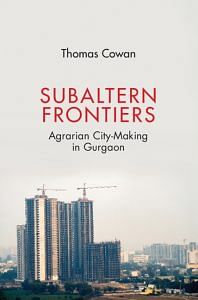The term chaloo was used frequently in jest by residents at Patwar Ghar to nod to the ethical dilemmas a patwari’s work required and was embroiled in. As Laura Bear has argued, neoliberal state development schemes that are heavily driven by private sector investment place local bureaucrats in awkward and ‘parallel’ relationships with the private sector through which local state actors broker political and economic space. In Gurgaon, I would argue that this bureaucratic awkwardness is made sense of by local state actors through a practice of ‘cunning’.
A chaloo was ‘corrupt’ in a mainstream sense, they will take payments to bypass or fast-track ordinary procedures, payments which are now near-mandatory for all bureaucratic work to be processed, and for this the term was used to lightly mock the necessary ethical transgressions of the office. As the majority of those working at Patwar Ghar are not salaried but rather earn solely through these payments, being cunning is an essential requirement for earning a living. This may mean that the chaloo bureaucrat is as likely to be hunched over mutation scripts and processing mundane paperwork as they are to be mixing with local politicians and elites. The chaloo is resourceful and innovative: they can navigate the system, find solutions to any manner of problem and remedy mistakes. As the previous case of the swapped land plots demonstrates, cunning and craft not only indicates a compulsion to engage in underhand tactics but also the necessity to fix the ambiguities and uncertainties that bureaucratic materials constantly throw up.
Parveen was an assistant patwari at Patwar Ghar highly renowned and sought after for such chaloo work. Parveen was originally from a village in south Gurgaon, a region that – as discussed in Chapter 3 – has been subject to significant real estate investment since its incorporation into the Gurgaon– Manesar urban development plan in 2007. Parveen was from an upper-caste Brahmin family and had utilised his social networks and connections to not only access a public sector job but also generate substantial work through the office. Parveen had an office but seldom used it. Where other offices were characterised by a dizzying coming and going of requests for mutations, partitions, income certifications and so on that were deftly prioritised and navigated by the assistant patwaris, Parveen’s office was far quieter.
The patwari for the office, involved in party politics in Rohtak, was a sometimespresent feature in the office, and the junior assistant sat in the corner of the room attending to the slow drip of ‘village work’ that every so often came in. Parveen on the other hand could be found in and around Patwar Ghar, often sat in the midday sun surrounded by a host of village headmen (lambardars), brokers and lawyers. They came to access Parveen’s services in navigating the revenue department. Some came requesting what Parveen called ‘big jobs’, hiring Parveen to work as a private consultant in the office, while others – corporate developers or upper-class Delhiites unaccustomed to Haryanvi rural life – hired Parveen to translate the system, access signatures or bypass certain prerequisites to property title mutation and registration. Parveen would, for example, work on contracts for local businessmen and property dealers, and frequently carried out work for a local sarpanch. The sarpanch of a village in north Gurgaon worked as a loan shark, taking land on as security and had built up a property empire from the business. Where creditors were unable to pay, the sarpanch would take on the land and hire Parveen to dig out the land from the record and organise the mutation in title.
Parveen was also well known for fixing clients with lambardars. Lambardars are village-level and sub-village level ‘headmen’ that are employed by the state to collect taxes, assess local cultivation and certify village documentation. The lowest position in the revenue department hierarchy, the lambardar is the final point of contact between the village and the state bureaucracy. The thumbprint or signature of a lambardar gives the impression of local connection to the village often necessary to certify notifications and property partitions and mutations.
Just like everyone else at Patwar Ghar, the lambardar’s tentative connections to both the state bureaucracy and the real estate industry has provided many with opportunities to dodge dispossession orders, regularise their territorial claims and build modest property businesses. Parveen was an expert in sourcing lambardars for faraway developers, equipping grand multinational property deals with a sense of localness that they required to pass through the bureaucratic office.
Chaloo work is frequently involved in sanctioning property transactions within Gurgaon’s ‘unauthorised’ colonies discussed in the previous chapter. Formally under the HDRUA, all property transactions on land below 1 acre require a ‘no objection certificate’ (NOC) from the Department of Planning in order to regulate the development of unsanctioned, nonlicenced neighbourhoods. But for small-time villagers cutting plots on their agricultural land like those in the previous chapter, the land aggregation requirements and costs of the HDRUA’s licence system are such that many seek to quietly register property transactions without the NOC. Gurgaon’s planning apparatus may be constituted through the selective incorporation of corporate layout plans and aggregation programmes, but it is not entirely disposed for small-time colonisers. For an NOC, one needs a patwari.
Parveen’s mid-day moonlighting is characteristic of those who occupy the ‘shadow’, informal spaces of public office. Parveen is a private actor – informally hired as an ‘assistant’ – deeply embedded in the everyday running of public office. The splintering geography of the state bureaucracy is of course the subject of much scholarly work. In her writing on ‘informality’ in South Asia, Barbara Harriss-White notes that the rise of so-called informal economies in Karachi brought with them ‘informal’ manifestations of the state. The rapid transformation of Karachi from a ‘pleasant’ colonial port to a bustling megalopolis in the post-colonial period, Harriss-White asserts, has been facilitated by a ‘shadow state’ apparatus lodged with intermediaries of varying social background that informally legitimate and link illegal settlements with state services. These intermediaries – engineers, construction contractors, local party bosses and of course bureaucrats – tentatively stitch together the sovereign fragments of a ‘non-hegemonic’ state, representing the bleeding boundaries of code and practice that structure state power in post-colonial South Asia. As the respective works of Solomon Benjamin and Partha Chatterjee have shown, the ‘messiness’ of the bureaucratic structure opens up spaces for the urban poor to vest themselves and regularise tentative claims on urban spaces.
And yet, while Parveen and others at Patwar Ghar are involved in regulating the improvised territorial settlements of marginal village actors, of doing ‘village work’, they are also at the same time utilising the office to service the interests of corporate real estate actors. At Patwar Ghar, corporate real estate is as much a beneficiary of the double-headed bureaucrat and their ambivalent records and maps – straddling both public and private, code and practice – as the urban poor. Indeed in agrarian cities like Gurgaon, which have only recently enveloped the rural world, where working-class migrants are locked into housing systems within village tenements (and not ‘squatting’ land as described in other cities) the low-level bureaucratic spaces are primarily spaces that link up global real estate with the aspirational agrarian world – where the tentative and shifting class alliances underpinning the Gurgaon model are assembled and bureaucratically smoothed over. With land and labour so tightly controlled in the first instance by agrarian Jat and Yadav landowners forged out of the colonial–post-colonial agrarian settlements, it is perhaps no surprise that the governance of land and labour is saturated by the ‘casted’ class interests of those same groups.
Also read: Why did JRD Tata’s Air India have 8,000 artistic treasures? Raza, Husain, ashtrays by Dali
Liaisoning Gaps
Such is the importance of this revenue work to corporate developers in Gurgaon, there are other actors at Patwar Ghar. Alongside the patwaris, kanungos and their assistants, there is a host of private actors, billed as ‘liaisoners’, ‘company patwaris’ or ‘revenue consultants’ who sit resident in the courtyard and offices. These liaisoners are hired by corporate developers to dig for land, move paperwork through and between the various revenue offices, and facilitate the payments and persuasions to move files up the chain of clearances.
At first it was incredibly difficult for me to discern who was a liaisoner and who was a patwari. Many liaisoners are themselves former patwaris and are deeply involved in the everyday functions of the office. When not conducting their own work, they help assistants write out and make copies of paperwork, make amendments in the record, signpost visitors and contribute to office discussions over the best solution to a visitor’s requests.
The liaisoner’s work is not simply to negotiate with patwaris – they are required to deeply embed themselves in the social life of the office and record. If patwaris like Devendra and assistant patwaris like Parveen are ostensibly of the state, stepping out, then liaisoners are outside actors stepping in to state spaces. State space, structured ineluctably by unstable hegemonic class alliances, is here composed like an unbordered lattice of public faces and private interests stretched across the city. Of course, as developers may have projects all over the city, liaisoners are more mobile than patwaris, they ferry paperwork and signatured notes pertaining to revenue work across scattered offices of the revenue department and between their employers’ swanky offices in New Gurgaon and the planning department in the HUDA-developed district of the city.
 This excerpt from ‘Subaltern Frontiers’ by Thomas Cowan has been published with permission from Cambridge University Press.
This excerpt from ‘Subaltern Frontiers’ by Thomas Cowan has been published with permission from Cambridge University Press.



